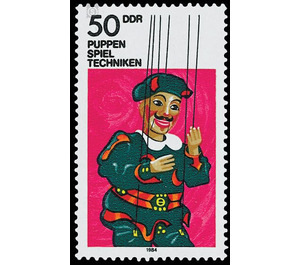puppet Theater - Germany / German Democratic Republic 1984 - 50 Pfennig
Theme: Art & Culture
| Country | Germany / German Democratic Republic |
| Issue Date | 1984 |
| Face Value | 50.00 |
| Color | green pink |
| Perforation | K 14 |
| Printing Type | Rotogravure 2 |
| Stamp Type | Postage stamp |
| Item Type | Stamp |
| Chronological Issue Number | 2618 |
| Chronological Chapter | GER-DDR |
| SID | 333674 |
| In 16 Wishlists | |
Theatrical dolls With the figures of theatrical dolls, the Ministry of Posts and Telecommunications of the German Democratic Republic issues two multicolored special postage stamps. Special stamps from June 5 to August 4 Puppet playing techniques The puppeteers across the world make use of certain leadership techniques that they have devised in the past and present to liven up their characters. The most common puppetry techniques are those for hand puppets, stick puppets, stick figures, puppets and shadow puppets, with the help of which silhouettes can be put on the screen. In addition, the players and ensembles, especially the state puppet theater in the socialist countries, use certain technical hybrid forms. With their help, figures can be moved in dimensions up to four meters. For a long time, stage directors of big scenes have used these theatrical possibilities and are using them in the interaction of human representation, mask and figure. The main actor on the puppet scene in the past was the "funny character". In Germany this u. a. Pickelhäring, Hanswurst, Kaspar and Kasperl, according to the models of the Viennese drama scene of the 18th and 19th centuries. Every nation with puppetry tradition has its funny person. To name just a few: Italy the "Pulcinella", Austria the "Kasper", France the "Guignol" and in Picardie the "Lafleur", England the "Punch", Denmark the "Meester Jackel", the Tsarist Russia the " Petrushka ", Czechoslovakia" Kasparek ", Hungary" Vitéz Läszlä ", Romania" Vasilache ", Greece and Turkey the" Karagöz ", India the" Vitusaka "and Indonesia the" Semar ", to name only the best known. Many of these figures can be seen in the puppet theater collection of the Dresden State Art Collection. Of course, the collection has a rich treasure of puppet characters of our territory. The oldest are from the end of the 18th century, the youngest from the present, because Kasper is still being asked to help in the GDR when it comes to dealing with problems with laughing mouths in interpersonal areas. 50 Pfennig value: The puppet shop The model for this value was provided by one of the marionette Kasper of the venerable Dresden puppet family Apel. Since the second half of the 19th century, they knew how to inspire their Saxon audience with Kasper. The Apels had several stationary stages in Dresden at the beginning of our century. They also toured other places in Saxony. The puppet-boxer "spoke" with his mainly adult audience as the only figure in the puppet scene. Therefore, he enjoyed the privilege of moving eyes and chin parts. Puppets, which have been detectable in our room since the Thirty Years' War, have ten to twelve threads (two head threads, two shoulder threads, two leg threads, two arm threads, a complementary thread, which focuses on the figure in the room) Back is attached and allows a bow, and one to two threads to guide the eyes and mouth). All threads open in a guide cross. From the height of the puppet bridge on which the players stand (usually two to three), the length of the laced threads depends. The perfect marionette game is the crown of this art.


